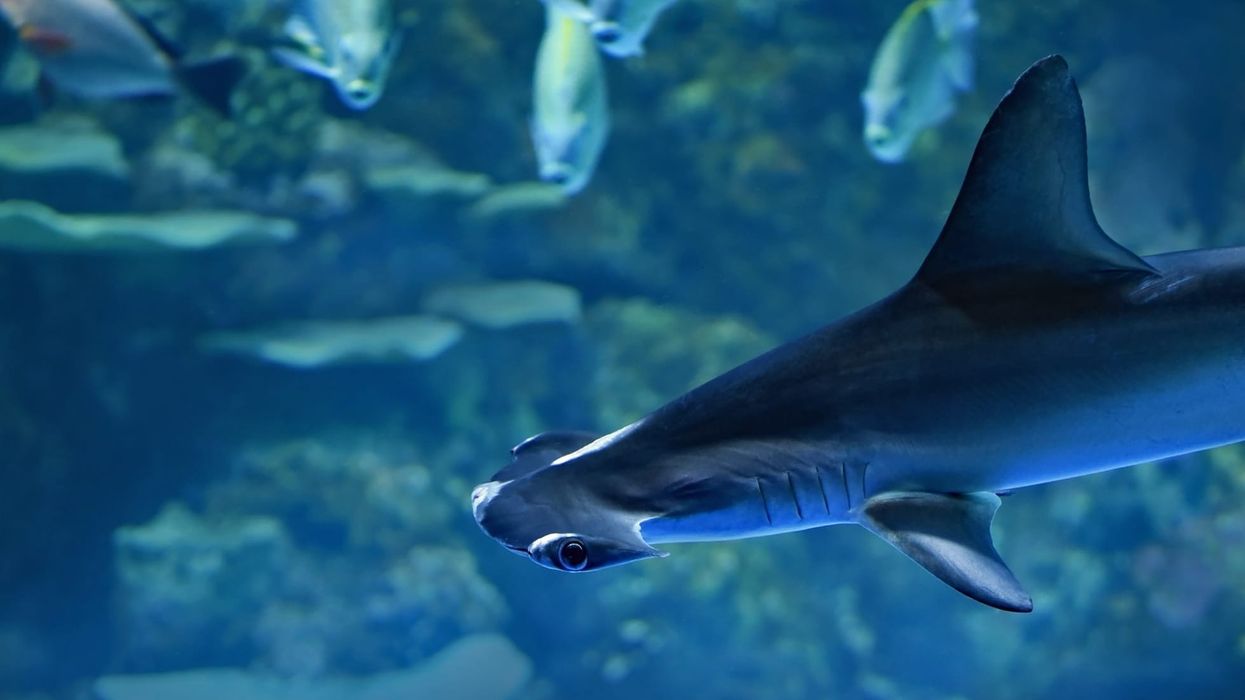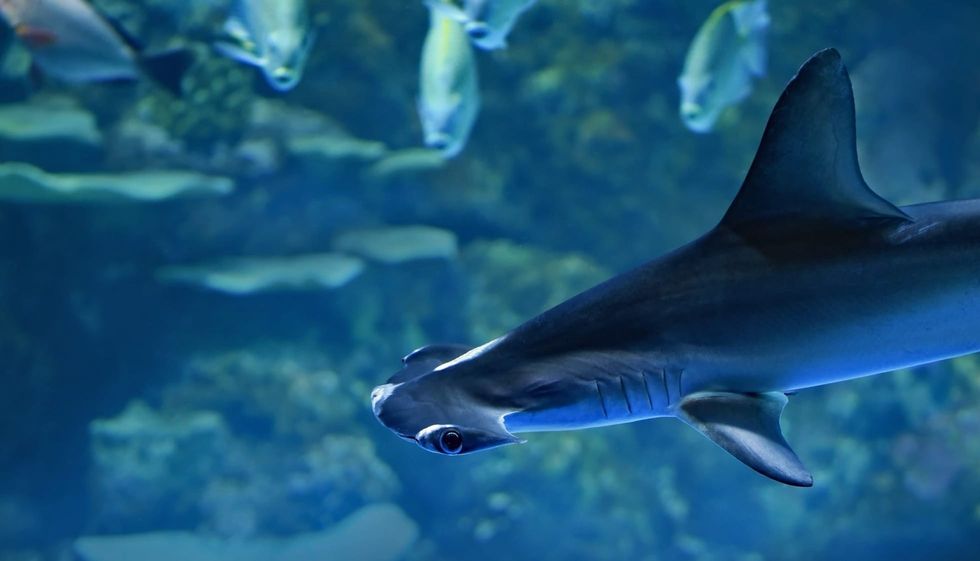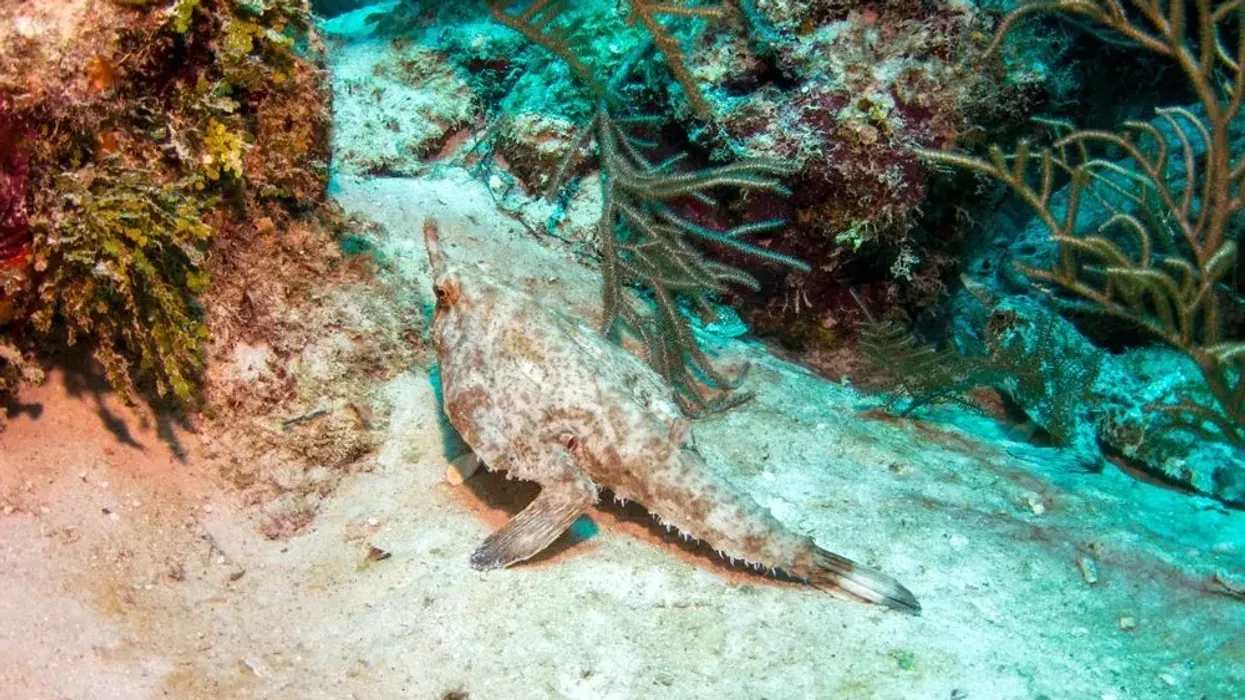A smalleye hammerhead shark belongs to the hammerhead shark species. It is known as the smalleye hammerhead shark as it has considerably small eyes.
Other species known from the genus Sphyrna are the great hammerhead shark (Sphyrna mokarran), the scalloped hammerhead shark (Sphyrna lewini), smooth hammerhead shark (Sphyrna zygaena), and the bonnethead shark (Sphyrna tiburo). There are nine different species from the family Sphyrnidae so far.
The smalleye hammerhead, Sphyrna tudes, is also known as golden hammerhead or curry shark due to the golden color body it inherits. It is recorded at the depths of 89-118 ft (27-36 m) in the shallow waters and coastal waters from Venezuela to Uruguay, especially concentrating Trinidad.
More precisely, it favors muddy habitats that are reflected through its small eyes.
The range and distribution of smalleye hammerhead sharks are vulnerable as the range is constantly declining. The IUCN Red List of Threatened Species downlisted the species to be Critically Endangered.
If the uniqueness of the smalleye hammerhead makes you interested to read more about similar species, you can read about saw shark facts and reef shark facts.
Smalleye Hammerhead Interesting Facts
What type of animal is a smalleye hammerhead?
A smalleye hammerhead shark, Sphyrna tudes, is one of the hammerhead species documented in the shallow and coastal waters of South America. It is also known as the golden hammerhead.
What class of animal does a smalleye hammerhead belong to?
The smalleye hammerhead shark belongs to the family Sphyrnidae. Some of the similar species of hammerhead sharks are great hammerhead, scalloped hammerhead, bonnethead, smooth hammerhead, and winghead hammerhead.
How many smalleye hammerheads are there in the world?
While there are nine species of hammerhead sharks recorded, the distribution and range of the smalleye hammerheads are yet to be computed.
According to the IUCN List, smalleye hammerheads are listed as Critically Endangered as are documented to be vulnerable due to various threats as fishing and their predators, such as the larger sharks like bull sharks (Carcharhinus leucas) and other hammerhead shark species (Sphyrna).
Where does a smalleye hammerhead live?
The smalleye hammerhead species are documented in South America. More precisely they are recorded in the shallow sea range from Venezuela to Uruguay. Trinidad, northern Brazil is known as a prominent nursing region for the hammerheads.
What is a smalleye hammerhead's habitat?
The smalleye hammerhead habitat ranges from shallow to coastal sea distribution. The small eye species are reported to prefer muddy habitats.
Who do smalleye hammerheads live with?
While adult males and young sharks, irrespective of their sex, are formed living in schools, adult females are documented to live quite solitary lives.
How long does a smalleye hammerhead live?
The smalleye hammerhead shark, Sphyrna tudes, is reported to live up to 20 years or more. Its life span depends on the survival of the species at a young age as juvenile species of sharks are often preyed upon, considering their size.
How do they reproduce?
While there are very limited biology reports highlighting reproduction in sharks, the smalleye hammerhead shark is viviparous in nature. Adult males and females reportedly mate from August-September and the gestation period in the adult females ranges up to 10 months.
Females give birth to 5-19 pups. Females give birth to young pups in May or June. Males and females turn adult once attain length up to 39 in (98 cm), while the length of the pups recorded is as small as 11.8-15.7 in (30-40 cm).
The pups feed on penaeid shrimp. The shrimp and egg of catfish are speculated to give rise to golden plumage on the shark's body with the presence of carotenoid pigment.
What is their conservation status?
The conservation status of the smalleye hammerhead shark, found in waters around Venezuela to Uruguay, is listed to be Critically Endangered under the IUCN Red List of Threatened Species.
Smalleye Hammerhead Fun Facts
What do smalleye hammerheads look like?
The smalleye hammerhead shark is golden-colored, often also called a golden hammerhead. Similar to other hammerheads, a smalleye hammerhead shark has a hammer-like head, called cephalofoil.
It has eyes at the edge of the cephalofoil that are considerably smaller in size, with nostrils positioned within the eyes. The mouth of the smalleye hammerhead shark is pretty curved with 15-16 teeth in the upper row while 15-17 lower teeth.
The first dorsal fin is taller than the second dorsal fin, which is smaller than the anal fish.
The first dorsal fin is sickle-shaped. The dorsal fins and the back of the sharks have gray plumage while pectoral fins, the anal fin, and pelvic fins range from yellow to orange color.
On the other head, juveniles are gray in color and inherit a body length of 11.8 in (30 cm); this is almost four times smaller than adult males and females. They are gray in color with longer hammer-sized heads.

How cute are they?
Smalleye hammerhead sharks are timid in nature and are thus appear to be cute. Further, the unique cephalofoil makes them attractive creatures.
How do they communicate?
While there is no research done to study the communication technique inherited by the smalleye hammerheads, Sphyrna tudes are speculated to communicate through body gestures and electric mechanisms.
How big is a smalleye hammerhead?
Smalleye hammerheads are one of the smallest hammerhead species. The shark's length is estimated to be 3.9-4.3 ft (1.2-1.3 m) long, which is eight times smaller than the biggest shark in the world, a whale shark.
How fast can a smalleye hammerhead swim?
The swimming speed of these sharks remains unknown. It is speculated that the hammerheads swim most of the time during the day, unlike many sharks.
How much does a smalleye hammerhead weigh?
This species of shark is recorded to weigh up to 20 lb (9 kg). This shark is the smallest species under its genus.
What are the male and female names of the species?
There are no sex-specific names labeled to the species. In general, they can be called either a smalleye hammerhead male or smalleye hammerhead female, respectively.
What would you call a baby smalleye hammerhead?
A baby shark is known as a pup.
What do they eat?
The status of the smalleye hammerhead diet makes them carnivores. The food of the shark mainly consists of fish, crustaceans, and shrimp. These sharks prey on their food mainly on the ground during the night. While the food of juveniles consists of penaeid shrimp, the food of adults ranges from sea catfish to eggs of sea catfish.
Are they dangerous?
While this shark is known to have timid behavior, they do not possess any danger. Moreover, they are harmless to humans until they are threatened. They are known to have good defense mechanisms against humans but are not life-threatening.
Would they make a good pet?
No, hammerhead sharks are wild species and not kept in captivity.
Did you know...
These hammerhead sharks are called hammerheads due to the resemblance of the shape of the head with a hammer. Sphyrna is a Greek word meaning 'hammer'.
Under biology, there are nine subspecies of hammerheads recorded: scalloped, bonnethead, smooth, small-eye, carolina, scoophead, and winghead hammerhead.
The shark is named after its small eyes and hammer-shaped head. Hence, is also known as a curry shark.
The small-eye hammer-head is reported to have smaller eyes at the edge of cephalofoil with a considerably small head size compared to scalloped, bonnethead, great hammerhead, and other hammerheads. These unique features also justify its name.
The mouth of this hammerhead shark is recorded to have 15-16 teeth in the upper row, while 15-17 lower teeth.
Not all species of hammerheads consume dolphins. Only smooth hammerheads are reported to consume dolphins.
What's the difference between a hammerhead shark and a smalleye hammerhead?
While both species belong to the same genus, a smalleye hammerhead has a pretty small length, compared to a hammerhead shark.
Is it illegal to catch hammerhead sharks?
Due to the over-fishing of the hammerhead sharks, humans are restricted to catch the hammerheads. To preserve and nurture the vulnerable hammerhead sharks, Trinidad emerged as the hotspot to prevent the sharks from going Extinct.
Here at Kidadl, we have carefully created lots of interesting family-friendly animal facts for everyone to discover! For more relatable content, check out these tiger shark facts and blacktip shark facts pages.
You can even occupy yourself at home by coloring in one of our free printable smalleye hammerhead coloring pages.










